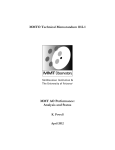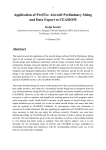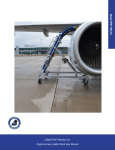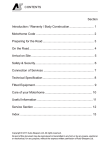Download 1 NATIONAL TRANSPORTATION SAFETY BOARD Office of
Transcript
NATIONAL TRANSPORTATION SAFETY BOARD Office of Aviation Safety Washington, D.C. 20594 Horizontal Stabilizer Trim Actuator Factual Report June 5, 2014 A. B. ACCIDENT DCA12RA025 Location: Date: Time: Aircraft: 70 nm South of Monterrey, Mexico December 9, 2012 About 0932 UTC Learjet 25, N345MC ATTENDEES Accident Site Documentation, December 11 - 14, 2012: Chairman: Captain Jorge Garcia Gallegos DGAC-Mexico Mexico City, Mexico Technical Advisor: Tom Jacky National Transportation Safety Board Washington, D.C. Technical Advisor: Jimmy Avgoustis Bombardier Aerospace Montreal, Canada Technical Advisor: Eric West Federal Aviation Administration Washington, D.C. Examination at the NTSB, September 16 - 20, 2013: Chairman: Captain Oscar Chapa Rivera DGAC-Mexico Mexico City, Mexico Member: Capt. Fermin Leon Gonzalez Colegio de Pilotos Aviadores de Mexico, A.C Technical Advisor: Michael Bauer National Transportation Safety Board Washington, D.C. 1 Technical Advisor: Jimmy Avgoustis Bombardier Aerospace Montreal, Canada Technical Advisor: Eric West Federal Aviation Administration Washington, D.C. Examination and Teardown at NTSB, February 20, 2014: C. Technical Advisor: Tom Jacky National Transportation Safety Board Washington, D.C. Technical Advisor: Jimmy Avgoustis Bombardier Aerospace Montreal, Canada Technical Advisor: Eric West Federal Aviation Administration Washington, D.C. SUMMARY On December 9, 2012, at about 0332 Central Standard Time, a Learjet 25, N345MC, crashed in mountainous terrain at an elevation of about 5,600 feet above mean sea level approximately 70 miles south of Monterrey, Mexico. The flight departed General Mariano Escobedo International Airport (MMMY), Monterrey, Neuvo Leon, Mexico at 0319 and was enroute to Lic. Adolfo Lopez Mateo International Airport (MMTO), Toluca, Estado de Mexico, Mexico. The two flight crew members and five passengers were fatally injured and the aircraft was destroyed. The Dirección General de Aeronáutica Civil of Mexico (DGAC) investigated the accident. The National Transportation Safety Board (NTSB) designated a U.S. Accredited Representative under the provisions of International Civil Aviation Organization (ICAO) Annex 13 as the State of Design, Manufacture and Registry of the aircraft. The airplane wreckage was documented at the accident site from December 11, 2012 to December 14, 2012 by the United States team, Bombardier, and technical advisors for the airworthiness aspects (structure, systems, powerplants). During that time the horizontal stabilizer actuator assembly components were identified by the technical advisors, removed from the accident site, documented, and retained by the DGAC for further examination. 2 On September 16th, 2013 pieces of the horizontal stabilizer actuator assembly were hand-carried to the NTSB Materials Laboratory in Washington, D.C. by a representative of the DGAC. The pieces of the horizontal stabilizer actuator assembly were among multiple components hand-carried to the NTSB by the DGAC representative. The components, including the pieces of the horizontal stabilizer assembly, were visually examined with no destructive tests conducted. After the examination at the NTSB, several of the examined components, including 2 pieces of the horizontal stabilizer actuator, were shipped to Varian Medical Technologies in Lincolnshire, Illinois. From September 26 to November 7, 2013 computed tomography (CT) scans were conducted on the components to provide information about their internal state and configuration. The results of the studies were provided to the NTSB and technical advisors from the United States. Following the studies, the components were returned to the NTSB. The US technical advisors met at the National Transportation Safety Board Materials Laboratory in Washington, D.C. on February 20, 2014 to examine and disassemble the horizontal stabilizer jackscrew assembly removed from the accident site. The horizontal stabilizer jackscrew pieces examined were the jackscrew assembly with the upper attachment point to the horizontal stabilizer and a piece comprised of the gear box housing and the jackscrew interface. The NTSB laboratory examination of the horizontal stabilizer trim actuator failure fracture surfaces exhibited evidence of single cycle bending overstress. No evidence of preexisting damage, corrosion or fatigue was noted in the examined components. D. DETAILS OF THE EXAMINATION 1. Description of the Horizontal Stabilizer Actuator The Horizontal Stabilizer Actuator provides longitudinal (pitch) trim of the airplane by controlling the angle of incidence of the horizontal stabilizer. The actuator is connected to the forward portion of the horizontal stabilizer. The bottom end of the actuator is connected to the forward spar of the vertical stabilizer. By extension and retraction of the actuator, the horizontal stabilizer is moved up and down to provide longitudinal (airplane nose up or airplane nose down) trim. For this airplane, the fully-extended position of the actuator corresponds to a horizontal stabilizer leading edge (full) up position of 1°-1.5° (airplane nose down). The fully-retracted position of the actuator corresponds to at horizontal stabilizer leading edge full down position of 8°7’-8°30’ (airplane nose up). The horizontal stabilizer actuator is electrically driven and includes a screwjack type of actuator. The mechanical screwjack portion of the actuator is located in a sealed housing and includes the screw, gears, bushings, and bearings. Over rotation of the 3 screwjack is prevented by mechanical stops. The stops are installed in both directions – airplane nose up and down. The actuator screwjack is operated by 1 of 2 electrical motors, a primary or secondary. The primary electrical motor can operate at either a high-speed or low-speed setting. The secondary motor provides autopilot pitch trim movements and is also a backup for the primary motor. The pitch trim indicator is located on the pedestal in the flight deck. The pitch trim switch is a three-position toggle switch used to select normal, emergency modes of operation or to turn the pitch trim system off. The switch is marked P TRIM, NORM, OFF, and EMER. The Emergency Pitch Trim Switch is located on the trim indicator panel on the pedestal. The switch is a three-position toggle switch used to manually change pitch when the pitch Trim Switch is set to EMERGENCY. The switch is marked EMERGENCY NOSE UP, and NOSE DOWN. The primary method to control pitch trim is by the pilot’s and co-pilot’s trim and TRIM Arming Switch, located on each control wheel in the flight deck. These pitch trim switches are marked NOSE DOWN and NOSE UP. 2. Examination at NTSB, September 16-20, 2013 The horizontal stabilizer actuator jackscrew was recovered at the accident site by DGAC investigators during the on-scene portion of the investigation. See Figure 1. Figure 1 - The Horizontal Stabilizer Actuator, jackscrew segment, in its found location at accident site (Photograph courtesy of the DGAC). 4 On September 16, 2013 the DGAC investigator arrived at the NTSB Materials Laboratory with various accident airplane components for further inspection. The components were unpacked, sorted and labeled. Fourteen (14) component sets were identified and photographed. Included were 3 components from the horizontal stabilizer actuator assembly. For the examination, the following horizontal stabilizer actuator assembly identification was used (See Figure 2): 2A – Is the jackscrew assembly and one attachment point. This attachment point connects the actuator assembly to the horizontal stabilizer. 2B – Is one of the actuator motors. The actuator motor is approximately 5 inches long and 2 inches in diameter. The actuator design contains two motors, only one motor was present at the inspection. Note: this segment was not retained following the September, 2013 examination; the segment was returned to the DGAC, and therefore not examined during this activity. 2C – Is one of the attachment points, the gear box housing and the jack screw interface. This attachment point connects the actuator to the vertical stabilizer. The jackscrew and tie rod were fractured adjacent to the gearbox. The gearbox housing plate was bent and 1 bolt was sheared from the attaching hole. 2C 2B 2A . Figure 2 - Pieces of the horizontal stabilizer actuator, as received. Attempts to X-ray the component using the Materials lab X-ray machine were unsuccessful. 5 At the request of the DGAC, items 2A and 2C were retained by the NTSB for computed tomography (CT) scanning at a future date (See Section D.3 below). The 2B component was returned to the DGAC representative on September 20, 2013. The DGAC was asked to review the remaining wreckage for the linear potentiometer assembly of the Horizontal stabilizer trim actuator. If located, the component will be subject to further CT scanning. No further information was received from the DGAC. 3. Computed Tomography of Horizontal Stabilizer Actuator The horizontal stabilizer actuator items 2A and 2C were sent, by the NTSB, to Varian Medical Technologies, Lincolnshire, Illinois for computed tomography (CT). The radiographic studies were accomplished from September 26 to November 7, 2013 at Varian Medical Technologies. The items were examined to document their internal state and configuration. The components were documented using computed tomography (CT) scans. Review of the images showed radiographic indications that were consistent with small particles in the area adjacent to the jackscrew, particles in a few other components, and damage consistent with impact damage. Following the CT scans, the items were returned to the NTSB in Washington, D.C. For additional information, please refer to Computed Tomography Specialist’s Factual Report, dated March 13, 2014. 4. Teardown of Horizontal Stabilizer Actuator at NTSB, February 2014 The U.S. technical advisors met 1 at the National Transportation Safety Board Materials Laboratory in Washington, D.C. on February 20, 2014 to examine the horizontal stabilizer jackscrew assembly previously examined (without disassembly) at the NTSB Materials Laboratory on September 16-20 2013. The examination was conducted in accordance with a test plan (Horizontal Stabilizer Trim Actuator Examination Test Plan), developed by the NTSB and approved by the attendees prior to the start of the examination. The examination and teardown of the horizontal stabilizer actuator was conducted with the assistance of an NTSB Senior Materials Engineer. The following was noted during the examination of the actuator: a) On piece 2A, the outer dust tube cover sleeve was cut longitudinally and removed from the actuator body. 1 The DGAC was invited but did not attend. 6 b) Debris was liberated when the dust tube was removed. The debris was collected and placed into a plastic bag. The removed dust tube was also placed in the plastic bag. Some debris remained inside the dust tube, at the crushed end of the tube. The debris collected appeared to be a mixture of ground soil, other organic material, and grease. c) Red, grease-like material was wiped off the exposed section of the jackscrew with a cloth. The cloth was saved in a plastic bag. The red material covered the exposed jackscrew and portions of the sleeve covered by the dust tube. d) The exposed jackscrew rod was bent relative to the actuator inner sleeve. The bend was measured on the Materials Laboratory’s level table as 6-7 degrees from the longitudinal axis of the actuator rod. e) The jackscrew outer sleeve was cut longitudinally, pried open, and then removed from the jackscrew. f) The jackscrew inner sleeve (the “nut” section to the screw) was twice cut longitudinally to remove the sleeve and expose the remainder of the jackscrew threads. Upon removal of the inner sleeve, red grease-like material was noted in both sections. The grease appeared to be fresh. During the cutting process, the jackscrew threads were inadvertently cut; however, the cuts did not affect the examination of the jackscrew fracture surface or threads. g) During a visual examination of the jackscrew and nut assembly by the NTSB Senior Materials Engineer, no evidence of pre-existing damage or corrosion was noted. No evidence of galling or abnormal wear was noted on the jackscrew or nut assembly threads. Fresh, red grease was apparent on the threads that appeared to have the color and consistency of Mobil 28 grease. h) Using computer imaging measurement software, the distance between the threaded jackscrew end stop and the end of the threaded section of the inner sleeve was measured as 0.96 – 0.98 inches. See Figure 3. 7 Nut Jackscrew End Stop Inadvertent Cuts Figure 3 - Jackscrew Thread Measurement. According to the NTSB Senior Materials Engineer, a visual inspection of the actuator jackscrew and tie bolt fracture surfaces located at the base of the actuator gearbox housing exhibited evidence of single cycle bending overstress. Based on the installed position of the actuator, the direction of the fracture indicated a fracturing force aft and to the left. See Figure 4. 8 Tie Bolt Jackscrew Figure 4 - Actuator Jackscrew Fracture Surface. According to the NTSB Senior Materials Engineer, the 6-7 degree bend of the jackscrew thread was not in the same direction as the bending overstress. According to the NTSB Senior Materials Engineer, the actuator’s inner tie rod exhibited visual evidence of extensive yielding adjacent to the fracture surface. According to the Senior Materials Engineer, the fracture surfaces on component 2C matches the fracture surfaces of 2A. According to the Senior Materials Engineer, no evidence of pre-existing damage, corrosion or fatigue was noted in the examined components. 5. Maintenance Records Related to the Horizontal Stabilizer Actuator Bombardier provided an electronic copy of the Learjet 25 Service Manual. According to the manual item number Q2740021, the Horizontal Stabilizer Actuator must be removed and overhauled each 600 flight hours. (See Attachment 1). The DGAC provided an electronic copy of the N345MC airframe log. From the log the following information was determined regarding the airplane’s Horizontal Stabilizer Actuator: a) Duncan Aviation overhauled the stab trim actuator for the accident aircraft in June 2005 (See Attachment 2). At the time, the accident aircraft had accumulated a total of 10,559 (ACTT) flight hours. 9 b) The last recorded flight time in the airframe log book was in July 2012 and indicates the aircraft had accumulated a total of 11,056 flight hours. (An average of 7 hours per month). c) From June, 2005 to July, 2012 the airplane had accumulated a total of 497 flight hours, an average of 5.9 flight hours per month. d) From July 2012 to December 2012, using an average of 5.9 flight hours per month, the airplane would have accumulated another 29.5 flight hours. e) Estimated flight time of the overhauled stab trim actuator at time of accident was 526.5 flight hours. Therefore, the horizontal stabilizer actuator was not due for overhaul for another 73.5 flight hours. 6. Calculated Horizontal Stabilizer Actuator Jackscrew Position Using the information from the Computed Tomography Specialist’s Factual Report, Bombardier calculated the horizontal stabilizer actuator jackscrew position as 1.17 degrees. The calculation was based on the CT radiographic study that indicated the jackscrew position was averaged to be 0.995 inches from its fully-extended position, and compared that information from the fully extended position as detailed on the Learjet 25 Service Manual, assuming that the travel as described in the Learjet 25 Service Manual is based on the actuator’s electric stops. Tom Jacky Aerospace Engineer 10



















